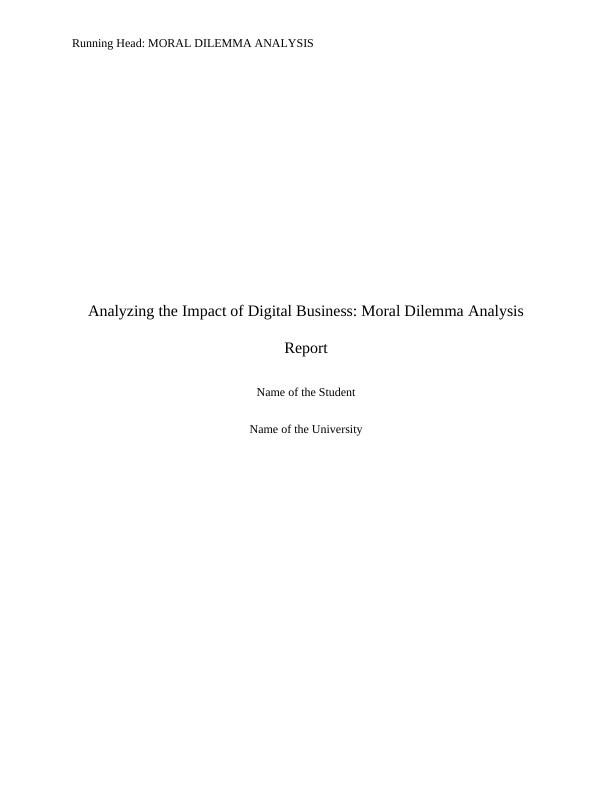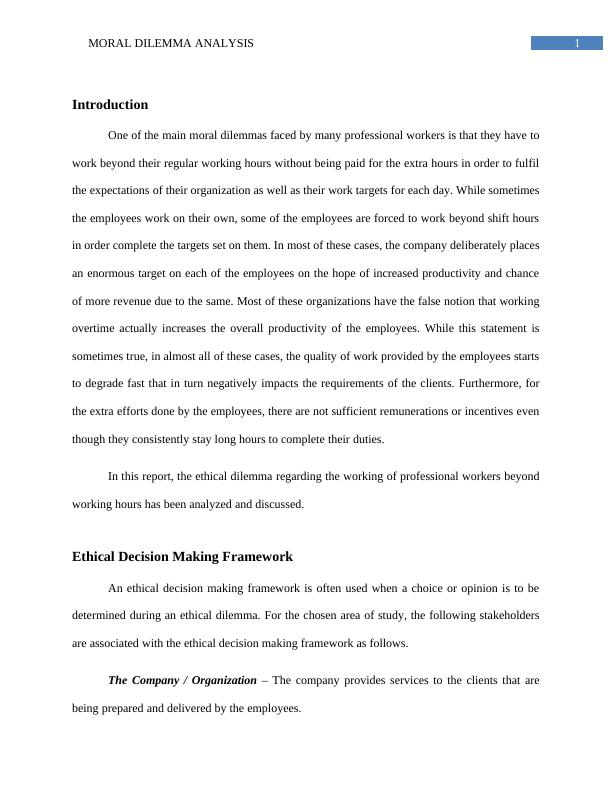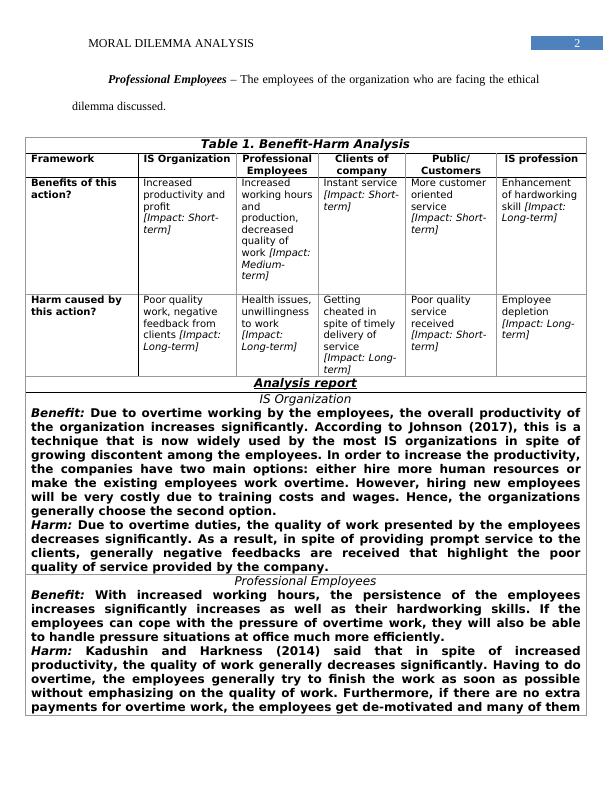Analyzing the Impact of Digital Business: Moral Dilemma Analysis
Added on 2021-06-16
13 Pages3578 Words40 Views
Running Head: MORAL DILEMMA ANALYSISAnalyzing the Impact of Digital Business: Moral Dilemma AnalysisReportName of the StudentName of the University

1MORAL DILEMMA ANALYSISIntroductionOne of the main moral dilemmas faced by many professional workers is that they have towork beyond their regular working hours without being paid for the extra hours in order to fulfilthe expectations of their organization as well as their work targets for each day. While sometimesthe employees work on their own, some of the employees are forced to work beyond shift hoursin order complete the targets set on them. In most of these cases, the company deliberately placesan enormous target on each of the employees on the hope of increased productivity and chanceof more revenue due to the same. Most of these organizations have the false notion that workingovertime actually increases the overall productivity of the employees. While this statement issometimes true, in almost all of these cases, the quality of work provided by the employees startsto degrade fast that in turn negatively impacts the requirements of the clients. Furthermore, forthe extra efforts done by the employees, there are not sufficient remunerations or incentives eventhough they consistently stay long hours to complete their duties.In this report, the ethical dilemma regarding the working of professional workers beyondworking hours has been analyzed and discussed.Ethical Decision Making FrameworkAn ethical decision making framework is often used when a choice or opinion is to bedetermined during an ethical dilemma. For the chosen area of study, the following stakeholdersare associated with the ethical decision making framework as follows.The Company / Organization– The company provides services to the clients that arebeing prepared and delivered by the employees.

2MORAL DILEMMA ANALYSISProfessional Employees – The employees of the organization who are facing the ethicaldilemma discussed.Table 1. Benefit-Harm AnalysisFrameworkIS OrganizationProfessionalEmployeesClients ofcompanyPublic/CustomersIS professionBenefits of this action?Increased productivity and profit[Impact: Short-term]Increased working hoursand production, decreased quality of work [Impact:Medium-term]Instant service[Impact: Short-term]More customer oriented service [Impact: Short-term]Enhancement of hardworking skill [Impact: Long-term]Harm caused by this action?Poor quality work, negative feedback from clients [Impact: Long-term]Health issues,unwillingness to work[Impact: Long-term]Getting cheated in spite of timely delivery of service[Impact: Long-term]Poor quality service received [Impact: Short-term]Employee depletion [Impact: Long-term]Analysis reportIS OrganizationBenefit: Due to overtime working by the employees, the overall productivity ofthe organization increases significantly. According to Johnson (2017), this is atechnique that is now widely used by the most IS organizations in spite ofgrowing discontent among the employees. In order to increase the productivity,the companies have two main options: either hire more human resources ormake the existing employees work overtime. However, hiring new employeeswill be very costly due to training costs and wages. Hence, the organizationsgenerally choose the second option.Harm: Due to overtime duties, the quality of work presented by the employeesdecreases significantly. As a result, in spite of providing prompt service to theclients, generally negative feedbacks are received that highlight the poorquality of service provided by the company.Professional EmployeesBenefit: With increased working hours, the persistence of the employeesincreases significantly increases as well as their hardworking skills. If theemployees can cope with the pressure of overtime work, they will also be ableto handle pressure situations at office much more efficiently.Harm: Kadushin and Harkness(2014) said that in spite of increasedproductivity, the quality of work generally decreases significantly. Having to doovertime, the employees generally try to finish the work as soon as possiblewithout emphasizing on the quality of work. Furthermore, if there are no extrapayments for overtime work, the employees get de-motivated and many of them

3MORAL DILEMMA ANALYSISprovide poor quality work deliberately. The authors have also mentioned thatdue to this particular issue, many of the employees face severe health issuesdue to working overtime. Persistent health issues decrease the overall workefficiency of the employees and have long term negative impacts.Clients of companyBenefit: According to Kang, Matusik and Barclay (2017), if the employees aremade to work overtime, generally the clients receive instant and prompt serviceas promised by the company itself. Harm: The clients of the company book services for the best quality of work andfor that purpose, they pay high amounts of money. However, as mentionedpreviously, due to overtime work, the employees’ performances fall significantlyand as a result, provide poor quality work. When the poor quality work isdelivered to the clients, they feel cheated to receive such quality even afterpaying so much money for the services.Public/CustomersBenefit: Working of overtime by the employees means the service is much morecustomer oriented i.e. the organization cares more about serving therequirements of the customer rather than the needs and importance of theemployees. Customer oriented service is much essential for developing a properbusiness relationship between the organization and the customers.Harm: Too much orientation towards the customers harms the interests of theemployees. Furthermore, in spite of customer oriented service, the quality ofwork delivered is very poor and hence, the customer satisfaction will decreaseconstantly unless the desired quality of service is delivered. This is not possibleif the employees are constantly forced to work overtime.IS professionBenefit: Due to overtime work, the IS profession gains more efficient employeeswho have much more hardworking skills and pressure management skills thanother regular employees. Furthermore, they are also able to develop new andshortcut methods to provide a service that save a lot of time and resources. Harm: However, according to Johnson (2017), not all employees are able to copewith the extra work and often resign from their jobs. Also, the overtime workhas some negative impacts on the health of the employees and they are forcedto leave their work. As a result, employee depletion occurs in the organizationand the IS profession as whole.Table 2. Analysis of Benefit, Harm and Contradiction when Universalized FrameworkISOrganizationProfessionalEmployeesClients ofcompanyPublic/CustomersISprofessionBenefits if Increase in EnhancemeIncrease Fast delivery

End of preview
Want to access all the pages? Upload your documents or become a member.
Related Documents
Ethical Issues in the Organizationlg...
|14
|3664
|86
Ethical Decision Making Frameworklg...
|11
|3105
|113
Ethical Dilemma : Assignment Samplelg...
|10
|3667
|132
HLTEN508B Apply Reflective Practice, Critical Thinking and Analysis in Healthlg...
|10
|4864
|106
Ethical Dilemma Regarding Early Launch of a Productlg...
|7
|2145
|60
Ethical Issues for IT Security Personnel- Doclg...
|5
|1029
|46
